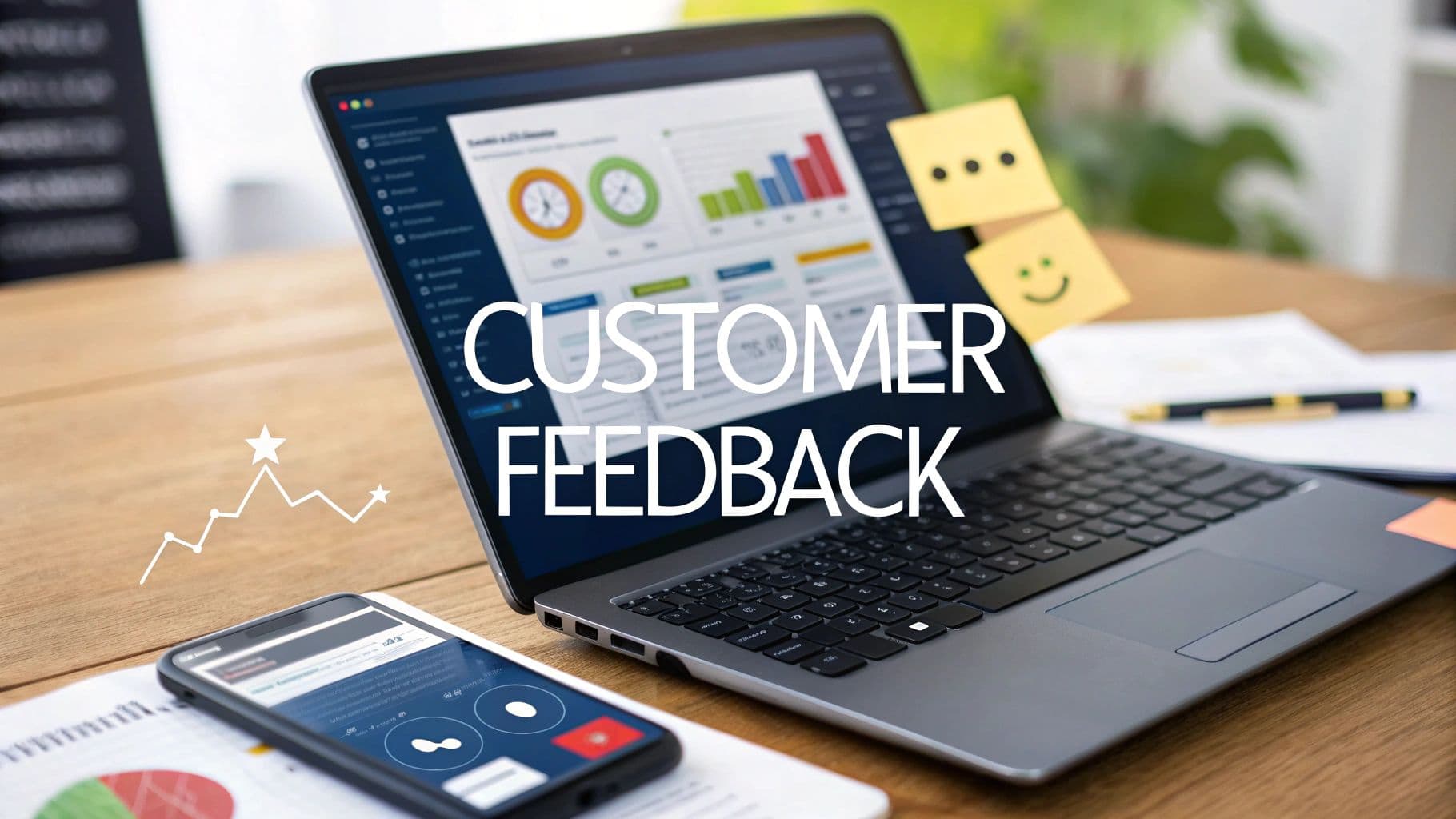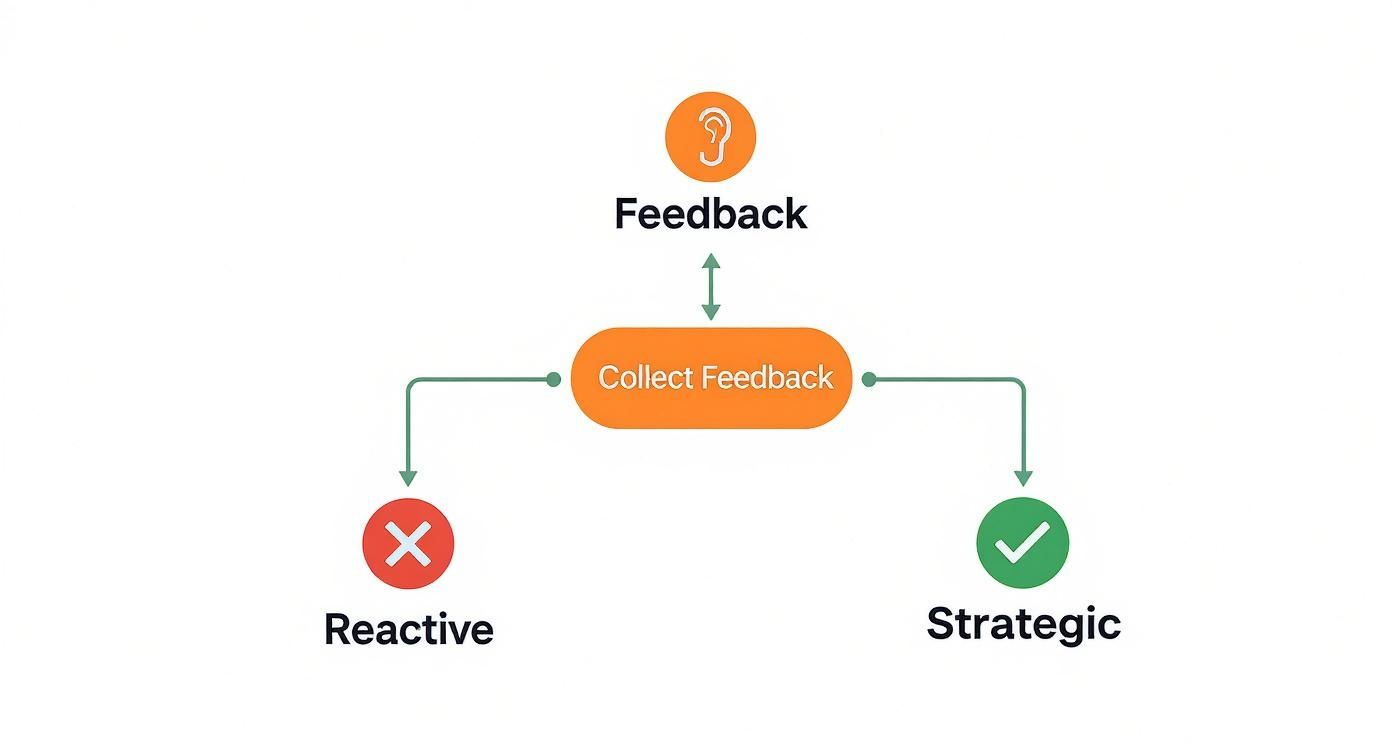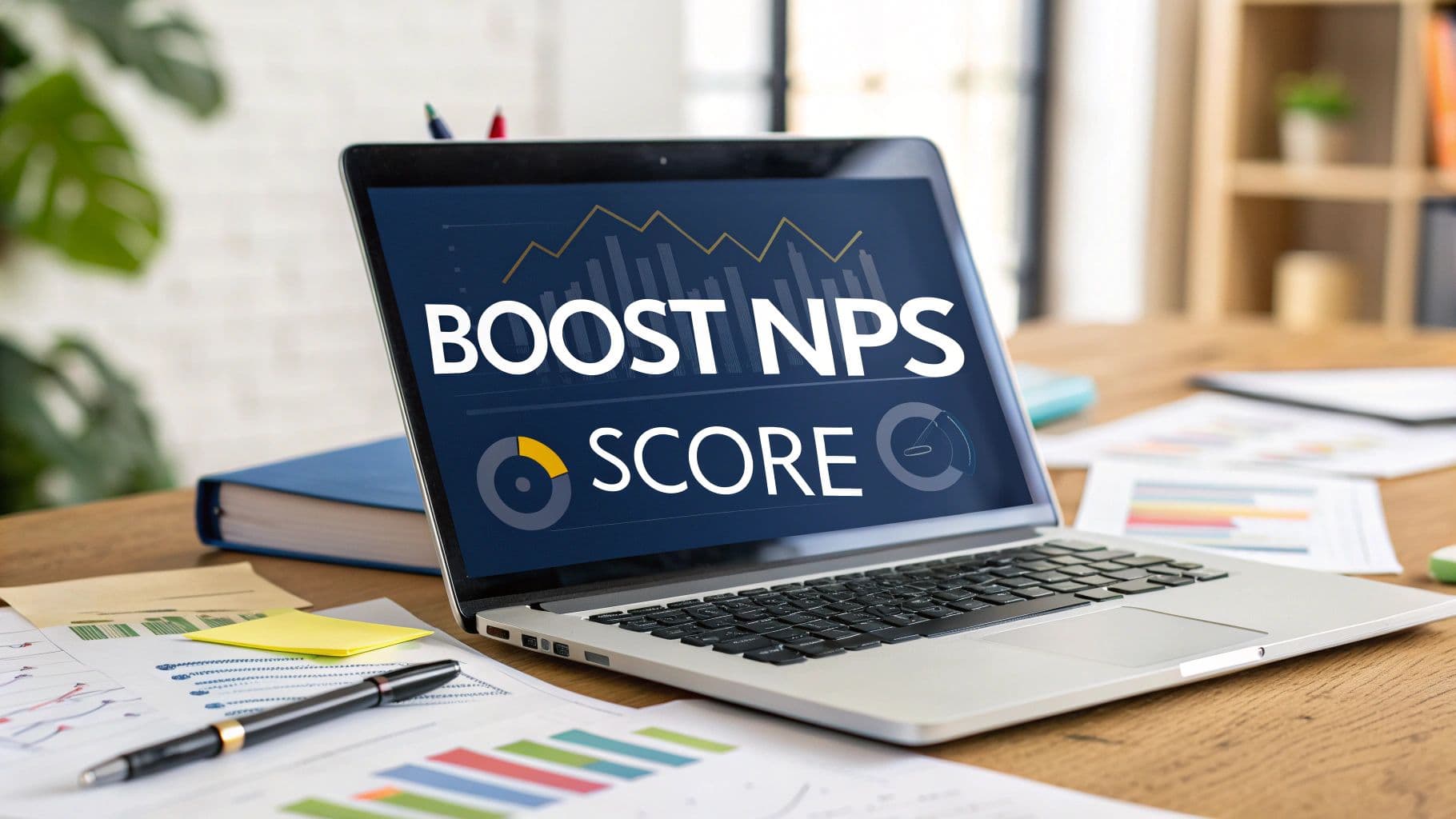How to Collect Customer Feedback That Drives Growth
Learn how to collect customer feedback with strategies that actually work. Discover the right channels, tools, and methods to improve customer loyalty.

Collecting customer feedback is about more than just sending out a survey. It's about opening up a conversation with the people who use your products and services every day. You're using tools like interviews, surveys, and even simple in-app prompts to gather real-world insights, and then you're turning that data into real improvements.
The goal isn't just to listen; it's to create a continuous dialogue that drives growth and builds genuine customer loyalty.
Why Customer Feedback Is Your Growth Engine
Before we get into the nuts and bolts of how to collect feedback, let's talk about why it's so critical. It wasn’t long ago that feedback was seen as a reactive chore—something you dealt with when a complaint came in. That mindset is completely outdated. Today, feedback is the engine for proactive growth.
The best companies aren't waiting for problems to surface. They're building systems to understand what their customers need before they even ask for it. This isn't just good customer service; it's a massive competitive advantage.
This whole shift is happening because the business landscape has changed. By 2025, customer experience is expected to be the main battleground, with a staggering 80% of executive leaders calling it their primary differentiator. Companies are moving beyond just fixing what's broken. They're using feedback to predict what customers will want next and what might cause frustration down the road. This allows your marketing, product, and support teams to get on the same page and build solutions that actually hit the mark.
From One-Off Interactions to Continuous Dialogue
To really nail this, you have to change your perspective. Stop thinking of a survey response or a support ticket as a one-and-done interaction. Instead, see each one as a single entry in an ongoing conversation with your customer. This approach, sometimes called Experience-as-a-Service (EaaS), turns the customer relationship from a series of transactions into a genuine collaboration.
When you adopt this mindset, it changes everything you do:
- Product Innovation: Feedback becomes a direct pipeline to your R&D team, telling you exactly what to build next.
- Marketing Resonance: You start speaking your customers' language, which allows you to create messaging that truly connects.
- Customer Loyalty: People who feel heard don't just stay customers; they become your biggest advocates.
Ultimately, collecting feedback isn't just about charts and data points. It's about building a business that listens, adapts, and grows with its customers. To learn more about turning these conversations into strategy, check out our guide on how to conduct a comprehensive voice of customer analysis.
Choosing the Right Feedback Channels for Your Audience
If you want to learn how to collect customer feedback that actually matters, you have to do more than just send out a generic survey. That’s the fastest way to get your request deleted. The secret is to meet your customers where they already are, using methods that feel like a natural part of their experience with you.
Think about it. A busy project manager knee-deep in your B2B software isn't going to stop what they're doing to answer an SMS survey. They're much more likely to click on a quick in-app prompt or set aside time for a well-structured email questionnaire. On the other hand, someone who just bought a pair of sneakers from your online store would probably have no problem tapping out a quick star rating via text, but a one-on-one interview? Not a chance.
This is the core difference between a reactive approach and a strategic one when it comes to gathering customer insights.

As you can see, a strategic process paves the way for real growth. A reactive one just leads to dead ends and wasted effort.
Match the Channel to the Customer Journey
Knowing your audience's behavior is everything. One global study that surveyed over 23,000 consumers found something fascinating: while people are more than willing to give feedback after a great (or terrible) experience, the way they prefer to do it changes dramatically depending on where they are and what they're doing. This just confirms that a one-size-fits-all strategy is a recipe for failure.
You need a mix of channels that align with different moments in the customer journey.
Comparison of Customer Feedback Collection Methods
To figure out the right mix for your business, it helps to see the popular feedback channels laid out side-by-side. This table breaks down each method, showing what it’s best for, its main advantages, and the potential downsides you should keep in mind.
| Method | Best For | Pros | Cons |
|---|---|---|---|
| Email Surveys | Detailed feedback after key events (onboarding, purchase, support ticket resolution). | Customers have time to give thoughtful, in-depth answers. | Lower response rates than other methods; can feel impersonal. |
| In-App Prompts | Capturing immediate, contextual feedback on specific features or user flows. | High response rates; provides real-time, actionable data. | Can be disruptive if overused; best suited for short, simple questions. |
| One-on-One Interviews | Deep qualitative insights, exploring complex problems, and validating new ideas. | Uncovers the "why" behind user behavior; builds customer relationships. | Time-consuming and expensive to scale; requires skilled interviewers. |
| Social Media Listening | Gathering unsolicited, honest opinions and tracking brand sentiment. | Authentic, unfiltered feedback; helps spot emerging trends or issues. | Lacks structured data; can be difficult to separate signal from noise. |
Ultimately, choosing the right method comes down to what you're trying to learn and who you're asking. Using this table as a starting point will help you build a more intentional and effective feedback strategy.
Build a Multi-Channel Strategy
Relying on a single feedback source is like watching a movie in black and white—you get the basic plot, but you miss all the color and texture. A truly robust strategy needs to be multi-channel.
Putting this kind of system in place can feel overwhelming, but there are plenty of platforms designed to help. For a rundown of what's out there, check out this guide on the top customer feedback collection tools that can help you automate and organize the process.
The end goal is simple: make giving feedback feel effortless and intuitive for your customers. By diversifying your channels, you’ll not only boost your response rates but also collect richer, more representative data that can point your business in the right direction. With this foundation, you're ready to start designing surveys people will actually want to complete.
Designing Surveys People Actually Want to Fill Out
We’ve all done it. You click on a survey link, see a wall of questions, and immediately close the tab. When you ask for customer feedback, you’re asking for their time. To get the insights you need, the entire experience has to be designed with respect for that time.
The trick isn't some big secret; it's about making your survey feel less like an exam and more like a quick chat. Keep your questions direct, use simple language, and make the layout clean and intuitive. This simple shift doesn't just get more people to finish—it dramatically improves the quality of the answers you get back.

Write Questions That Uncover the Truth, Not Confirm Your Biases
The way you word a question can completely change the response. This is probably the biggest mistake I see teams make. Leading questions are the number one enemy of good feedback because they subtly push people toward the answer you want to hear, not what they actually think. It poisons your data from the very start.
For instance, asking, "How much did you enjoy our amazing new feature?" is loaded with bias. It already assumes the experience was enjoyable and positive.
A much better, neutral approach is to ask, "What was your experience like using our new feature?" This opens the door for genuine, unfiltered opinions—both good and bad.
Keep It Short and Show Them the Finish Line
Ever heard of survey fatigue? It’s a very real thing. Nothing makes people abandon a survey faster than seeing an endless scroll of questions. In my experience, a focused five-question survey that people actually complete is infinitely more valuable than a 20-question beast that 50% of users abandon halfway through.
Be transparent about the time commitment. A simple progress bar or a "Question 3 of 5" indicator does wonders for keeping people engaged. When they can see the end is just around the corner, they're far more likely to stick it out.
Here are a few practical tips I always follow for structuring surveys:
- Ease them in. Start with simple multiple-choice or rating scale questions. They're low-effort and get the ball rolling.
- Save demographics for last. If you absolutely need personal info like age or location, ask for it at the very end when they're already invested.
- Use smart logic. Don't ask questions that don't apply. If someone says they haven't used a feature, your survey should be smart enough to skip the questions asking them to rate it.
- Think mobile-first. A huge number of your customers will be taking the survey on their phone. Make sure it looks good and works perfectly, with big buttons and readable text.
When you design surveys with the user’s experience at the forefront, you turn what could be an annoying interruption into a genuinely helpful conversation. You'll build goodwill and, most importantly, collect data that truly reflects the voice of your customer.
Using Technology to Analyze Feedback in Real Time
Collecting customer feedback is just the start. The real magic happens when you can instantly understand what it all means and act on it—long before a small grumble turns into a major headache. Let's be honest, manually sifting through thousands of comments is slow, costly, and riddled with human bias. This is where technology truly flips the script.
Modern tools, especially those powered by AI, can chew through a mountain of raw feedback in seconds. They take all that unstructured data from surveys, support tickets, and social media chatter and turn it into clear, actionable intelligence. Instead of waiting weeks for a report, you can see trends and shifts in customer sentiment the moment they emerge.
Automating Insight Discovery
Imagine trying to find the common thread in 5,000 open-ended survey answers. An AI-powered system can do that in the time it takes to grab a coffee. It uses natural language processing (NLP) to pick out recurring themes, keywords, and the emotions behind them.
This moves you beyond simple satisfaction scores to grasp the why behind the numbers. For instance, an AI tool might reveal that while your overall CSAT score is holding steady, mentions of "slow loading times" have shot up by 300% this week, mostly from users in a specific region. That’s a hot lead you can pass directly to your engineering team. To make this happen, you need solid tips for tracking customer feedback effectively.
A Real-World Scenario: Unpacking Churn
Think about a subscription box company bleeding customers. Manually reading every "reason for leaving" comment would take an entire team days, if not longer. Instead, they plugged this data into an AI analysis tool.
Almost immediately, the system flagged a powerful link between cancellations and phrases like "duplicate items," "too similar," and "uninspired choices." The company believed its product curation was a key strength, but the data showed the exact opposite—it was a primary reason for churn, especially among their most loyal, long-term subscribers.
From Reactive to Proactive Analysis
This shift to real-time analysis isn’t just a nice-to-have; it's becoming essential. We're already seeing that by 2025, waiting around for feedback is a failing strategy because customers expect you to solve their problems now.
When you use AI to analyze feedback from quick surveys at key moments—like right after a purchase—your teams can get automated alerts on negative sentiment. This means you can jump in and resolve issues right away, which is huge for retention and loyalty.
The ultimate goal is to build a system that acts on feedback before issues snowball. Integrating a platform like SigOS with your existing tools creates this kind of always-on monitoring. You can explore a variety of customer feedback analysis tools to find what works best with your current setup. This approach turns feedback from a historical record into a powerful tool for predicting and driving future growth.
Turning Insights into Action and Closing the Loop
So you’ve collected a mountain of customer feedback. That's great, but the raw data itself is pretty useless if it just gathers dust in a spreadsheet. The real magic happens when you turn those comments, scores, and interviews into real, tangible improvements to your business. This isn't just about squashing bugs—it's about creating a system that consistently translates what customers are saying into action.
First thing's first: you have to separate the signal from the noise. It’s easy to get sidetracked. A single, fiery complaint from an angry customer can feel incredibly urgent, but a quiet, persistent issue mentioned by 50 different users is probably doing a lot more damage to your bottom line. Prioritization is everything.

From Data Points to Departmental Action
Once you’ve zeroed in on the high-impact issues, the next hurdle is getting that information to the people who can actually do something about it. Too often, feedback lives and dies with the support team. If you're serious about customer experience, building a cross-functional feedback loop isn't just a good idea—it's non-negotiable.
Here’s how you can make that insight useful for everyone:
- Product Teams: They don't need a flood of one-off tickets. They need themes. Instead of just forwarding a complaint, frame it as a clear trend. For example: "We've seen a 40% increase in feedback about confusion during the onboarding workflow, specifically at the 'invite team member' step." Now that's something they can work with.
- Marketing Teams: Give them the exact words your customers are using. This is absolute gold for writing copy that actually connects, creating help articles that solve real problems, and knowing which features to highlight in your next campaign.
- Sales Teams: Let them know about the common friction points. When a salesperson understands what frustrates current users, they can set better expectations for new prospects and head off potential issues before they even start.
This approach ensures customer feedback drives decisions everywhere, not just in one siloed department. If you want to dig deeper into the specific numbers you should be tracking, you can learn more about key client satisfaction metrics.
The Power of Closing the Loop
This might be the most overlooked—and most powerful—part of the entire process. Closing the loop simply means getting back to the customers who gave you feedback and telling them you acted on it. It’s the difference between a customer feeling like they’re shouting into the void and feeling like a valued partner in your journey.
And it doesn't have to be some massive, complicated initiative. It can be as simple as a targeted email to everyone who complained about a specific problem:
"Hi [Name],
A few weeks ago, you mentioned that our reporting dashboard was slow to load. We listened, and I'm excited to let you know we just rolled out an update that makes it 3x faster. Thanks again for helping us make the product better."
That simple, personal follow-up does so much more than announce a new feature. It validates the customer’s time and effort, shows you're actually listening, and builds incredible loyalty. When you make this a standard part of your process, feedback stops being a one-way street and becomes a powerful tool for building lasting relationships.
Common Questions About Collecting Customer Feedback
Even with a great plan, you're bound to hit a few snags when you start collecting customer feedback. It happens to everyone. Let's walk through some of the most common questions I get asked and cover some practical, battle-tested ways to handle them.
How Often Should I Ask for Feedback?
This is a classic balancing act. You want to be engaged, not annoying. The right answer really depends on where and when you're asking. You wouldn’t dream of sending a long-form email survey after every minor interaction, but a quick thumbs-up/thumbs-down after a support chat? That feels completely natural.
A good rule of thumb is to anchor your feedback requests to key moments in the customer's journey:
- Right After Onboarding: How did it go? Did they get set up for success? This is your chance to find out.
- Post-Purchase: Ask about their checkout experience or what they think of the product so far.
- After a Support Ticket is Closed: This is the perfect time to capture how they feel about the resolution, while the memory is still fresh.
- Quarterly or Bi-Annually: For your long-term customers, a broader relationship survey can be a great way to check the pulse on overall satisfaction and loyalty.
The real trick is to set some ground rules in your tools to avoid burning out your customers. A simple setting like, "don't survey the same user more than once every 30 days," can do wonders for preventing fatigue and keeping your response rates from tanking.
What if I Only Get Negative Feedback?
First off, take a deep breath. A flood of negative feedback can feel like a punch to the gut, but it's actually a goldmine. These are the people who care enough to complain instead of just walking away silently. They are literally handing you a to-do list for fixing your business.
Start looking for patterns. Is the same complaint coming up over and over? Are people getting stuck on the same feature? This is where the magic happens. You’ll find your biggest opportunities hidden inside your biggest problems. The goal isn't to silence the complaints; it's to use them to build something better.
How Can I Encourage More People to Respond?
Low response rates are frustrating, but almost always fixable. When people don't respond, it usually boils down to two things: it feels like too much effort, or they don't think you're actually listening.
To get more people to chime in, you have to tackle both issues head-on.
- Make It Ridiculously Easy. Shorter is always better. Five simple questions will get you more answers than twenty complex ones. Stick to rating scales and multiple-choice, and for heaven's sake, make sure it all works perfectly on a phone.
- Close the Loop. This is, by far, the most effective thing you can do. When customers see that you actually act on their feedback, they're infinitely more likely to give it again. Announce product updates that came directly from customer ideas. You could even send a personal thank-you email to someone who gave you a game-changing insight.
When you respect their time and show them their voice truly matters, you change the dynamic completely. It stops being a chore and starts feeling like a partnership.
Ready to turn scattered customer comments into your most powerful growth engine? SigOS uses AI to analyze support tickets, sales calls, and usage data, showing you exactly which issues are impacting revenue and which feature requests will unlock major growth. Learn how SigOS can help you prioritize with confidence.
Keep Reading
More insights from our blog


